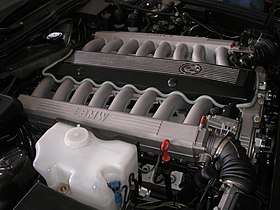BMW Goldfisch V16
The BMW Goldfisch is a SOHC 32-valve V16 6.7-litre prototype automotive piston engine based on the BMW M70 V12 engine.[1]
| BMW Goldfisch V16 | |
|---|---|
 | |
| Overview | |
| Manufacturer | BMW |
| Also called | BMW V16 |
| Production | 1987 |
| Layout | |
| Configuration | V16 |
| Displacement | 6,651 cc (405.9 cu in) |
| Compression ratio | 8.8:1 |
| Combustion | |
| Fuel type | Gasoline |
| Output | |
| Power output | 408 PS (300 kW) |
| Torque output | 62.5 kp·m (613 N·m)[A 1] |
| Dimensions | |
| Dry weight | 310 kg (683 lb) |
Development
Development started in the late 1980s. The engine was built to demonstrate the maximum potential of the small cylinder displacement engine family. Also, a three cylinder model of the same engine family was made to set a minimum. Development started on July 8, 1987, and by the beginning of 1988 the engine was ready. It was put on a dynamometer in January and February 1988. Afterwards, it was installed in a modified long wheelbase BMW 7 Series (E32), and the first driving tests were made in May 1988. On July 7, 1988, the engine was presented internally within BMW.
To prevent an "arms race" with other engine manufacturers, the V16 was never put into mass production.[2] Additionally, a higher-performance version of the M70 engine, the S70B56 installed in the BMW 850CSi, produced 380 PS (279 kW) and 56.1 kp⋅m (550 N⋅m) of torque, almost reaching the power output of the V16.[3]
This engine was also trialled in the Bentley Mulsanne as a potential "upgrade" from a turbocharged V8 engine. Unlike the 7 Series, the engine fit in the bay with room for radiator and ancillaries.[4]
Technology and performance
The engine design virtually copies the BMW M70 V12 layout but with 4 more cylinders added.
- 6,651 cm3 60°-V16 engine
- Cast aluminium block and cylinder heads
- SOHC, 2 valves per cylinder
- Bore and stroke: 84 × 75 mm (3.3 × 3.0 in)
- Bore spacing: 91 mm (3.6 in)
- Compression ratio: 8.8:1
- Maximum power: 408 PS (300 kW) at 5,200 rpm
- Maximum torque: 62.5 kp·m[A 1] (613 N·m) at 3,900 rpm
- Redline: 6,000 rpm
- Engine management: 2 separate Bosch DME 3.3 for each bank
- Dry weight: 310 kg (683 lb)
See also
Notes
- According to Karlheinz Lange, one of the engineers who worked on this engine, the maximum torque is 63.7 kp·m (625 N·m).
References
- Farmer, Gavin (March 2009). "The Secret Seven" (PDF). BMW Car. pp. 36–41. Archived from the original (PDF) on April 19, 2009. Retrieved August 6, 2009.
- "BMW Goldfisch". BMW Group Archiv (in German).
- Of, Andreas; Stegmaier, Gerd (April 10, 2017). "Geheimprojekt Goldfisch BMW 7er E32 750iL V16". Auto Motor und Sport (in German). Retrieved July 31, 2017.
- "Engine Types Explained: V16 Engine". Motor Car Net. Retrieved November 22, 2019.
Bibliography
- Lange, Karlheinz (1999). Geschichte des Motors - Motor der Geschichte. BMW Dimensionen 1+2 (1st ed.). München: BMW Mobile Tradition. ISBN 978-3-932169-04-5.